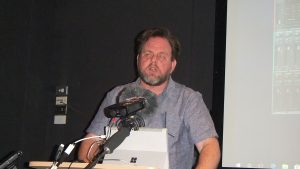Vice Chair Paolo Menolotto welcomed all to the meeting and before Steve Lincoln-Smith gave the main presentation on Digital Audio Interfaces, he introduced AES Member Alec Graham to give a brief introduction to the recent update to the ANSI/Infocomm Audio Coverage Uniformity (ACU) standard for the AV Industry.
Alec explained that AVIXA (formerly known as Infocomm) is the international trade association for the AV Industry, who have been working on an update to this standard for several years, and that he had been deeply involved with the process.
Alec briefly covered AVIXA ‘s activities, and their involvement in standards-setting for the industry.

He explained that the ACU standard was first published in 2009, and the recent effort was to review and update the standard.
He indicated that the decision was made to review and update the standard, and went on to describe a few of the changes made like broadening the standard to cover open-air as well as indoor venues, and the measurement process being changed from a time-lined process using RTA measurements at multiple locations within the listening area to a time-windowed response to simplify the measurement process and eliminate a lot of the effect of reverb colouring the results. Another change was to move from a pass/fail result for a measurement to one with six L5 classifications depending on the envelope – anywhere from 3dB to over 12dB, from the lowest point of audio coverage to the loudest.
Alec indicted that a Field Guide for the standard would be published later in the year, which would be in the form of a case-study in implementing the standard.
He suggested that, if there was interest, he could return then and use this resource to explain the standard in more detail.
Following Alec’s briefing, Paolo then introduced our main speaker, Steve Lincoln-Smith Managing Director of Innovative Music Australia to talk to us on the subject of “Format Wars in 2018 with Digital Audio Interfaces”
Steve brought with him some examples of USB interfaces from RME and Focusrite, and after giving us a quick introduction to what these devices were, he went on to enumerate the various digital interfaces available over the years – USB 1, USB 2, USB 3, Thunderbolt and Firewire – posing the question “which of these interfaces is best for connecting an audio interface – and importantly, which one will still be useable in 5 or 10 years’ time?”
His take on this was that it’s all about the bandwidth, and what we can do with it.
He noted that backwards compatibility is included with the latest standards, so most Firewire 400 devices can operate on a Firewire 800 connection, and with an adaptor many can also connect to a Thunderbolt port. Similarly most USB 1 and 2 devices can function on a USB 3 port.
Steve then covered the speed capabilities of the various interface standards starting with USB 1 at a paltry 12Mbps. He explained that USB 2 increased that to 480Mbps – a rate at which serious pro audio applications are achievable. At this data rate, 40 tracks of 24-bit, 96kHz audio become possible. This allowed manufacturers to cater for higher sampling rates, even up to 384kHz – but at a cost of lowered simultaneous input track count. He indicated that this was the route taken by Focusrite, with their USB 2 interfaces with 2 and 4 input boxes. He commented that, although this limits USB 2 interfaces to fewer inputs, most small/home studios don’t find this a practical issue.
He then covered the original Firewire 400 Mbps interface, which he remarked is a receding standard, eclipsed by USB 2 and the newer Firewire 800Mbps. He then covered USB 3 with a theoretical 5Gbps (and a likely practical 3.2Gbps) to enable a much higher channel count.
He then mentioned compatibility in RME’s USB 3 product, noting the many fully compatible chipsets, including Intel, and AMD – but that it should be noted that if the USB connector is connected to the motherboard via a cable, rather than being directly soldered to the motherboard, transmission errors can occur. He then indicated a few chipset implementations that were not compatible.
Steve then covered Thunderbolt-2 which is capable of 10Gbps, commenting that it is actually external PCI Express with added Plug&Play. He noted that, unlike previous standards, Thunderbolt-2 is under a very strict quality control and certification process, and that this rigid approach means it “just works”. This means that many audio manufacturers are moving to this interface.
After showing a summary graph of the bandwidths of the various interfaces, Steve then suggested that there was more to the performance of a particular digital audio interface device than the bandwidth of the data interface employed.
He commented that the controller chip firmware is a key element, and RME’s implementation of a virtual controller chip in an FPGA provides the flexibility of being able to update the controller firmware in the field at will.
Other key factors he suggested were the need for well-written software drivers, and how the clock signal is handled, going into some detail of the RME SteadyClock solution.
Steve then wound up his presentation with an on-screen demonstration of the virtual mixer available on a typical RME interface.
A wide-ranging Q&A session concluded the evening’s events.
A video has been produced of the slides + audio from the talks
The Video can also be viewed directly on YouTube at:
https://www.youtube.com/K3T1x2J08Gg
PDF copies of the slide deck used on the evening can be viewed or downloaded here
The audio only recording can be heard or downloaded here
Thanks to Graham Haynes and his trusty Tascam for the audio recording, and a special thanks to
The SAE Institute for the use of their excellent facilities

